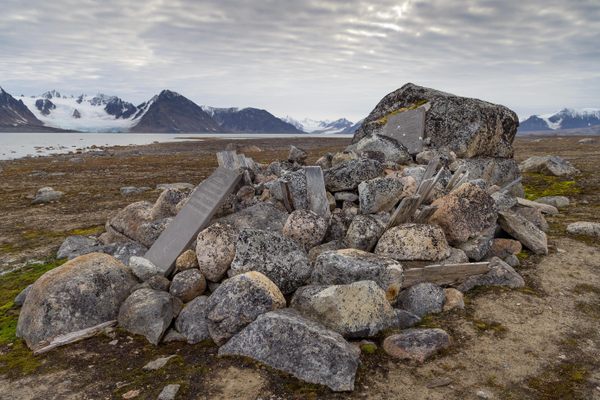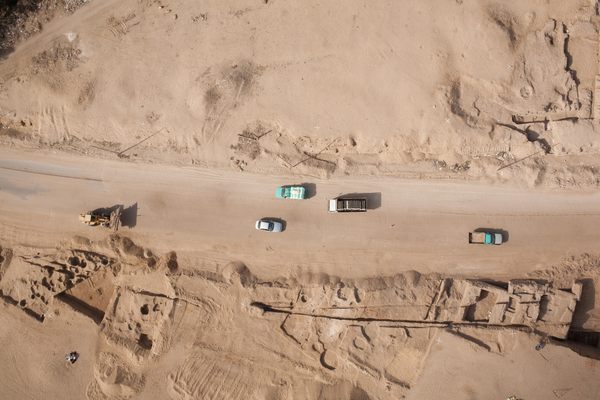The Vivid Blue Mineral That Grows on Buried Bodies and Confuses Archaeologists
Just mix together a dead person, some iron, and lots of water.


In 1861, a railway engineer by the name of John White passed away, was buried in a cast iron coffin, and began a slow transformation from White to blue.
The explanation for this spooky color change, which has occurred on numerous occasions all over the world, lies in the composition of the human body. Among the molecules contained within us is phosphate, a central phosphorus atom bound on four sides to atoms of oxygen. Phosphate is present in the hard bits of bones and teeth (as part of the mineral hydroxylapatite), helps hold together strands of DNA and RNA, and is used by cells to store and move energy around as well as to organize their many protein-driven activities.

If a dead person ends up buried somewhere waterlogged, lacking in oxygen, and loaded with iron, the phosphate leaking from their decaying remains can slowly combine with the iron and water to form a mineral called vivianite. It starts out clear and colorless, but will rapidly turn progressively darker shades of blue upon exposure to air as the iron within it reacts with oxygen. The formation of vivianite (also known as blue ironstone) is helped along by bacteria which act to dissolve iron out of soil and phosphate out of bodies while also directing the growth of the blue crystals.

In the case of Mr. White, in keeping with the styles of the time, his coffin had a glass window installed in the front so his face could be seen by mourners when the lid was shut. At some point after burial, the glass had broken, allowing groundwater to seep inside and react with the cast iron coffin and phosphate-rich body. The end result was a corpse surround by blue vivianite crystals, revealed when the coffin was exhumed as part of an archaeological rescue excavation over a century after being buried.
Vivianite can form in, on, and around human remains. It appears as crusty patches on bones, needle-like crystals within the pulpy centers of teeth, and discolored blotches on skin. It’s also been found on adipocere, the waxy gunk occasionally produced as fat-filled flesh breaks down under cold and wet conditions.
Partially blue human remains have been recovered from graveyards, past war zones, and alpine lakes and glaciers. As iron is an essential ingredient in vivianite, it tends to show up in naturally iron-rich locales or in cases where a corpse ends up near a source of the metal: cannonballs strewn about a battlefield, the site of a plane crash, or iron coffins in an older cemetery. The skin of Ötzi the Iceman, a 5,000-year-old mummy discovered in the Ötztaler Alps between Austria and Italy after the glacier it was encased in partly melted away, is dotted with blue spots marking where it had been in close contact with iron-bearing rocks.

In addition to giving the dead a splash of color, the presence of vivianite can both help and hinder their investigation by archaeologists and forensic researchers.
Firstly, vivianite can tell us about what happened to a person’s body after their death. In 1963, an American B-26B aircraft went down over a mountainous part of South Vietnam. Its crew was subsequently listed as missing in action. Decades after the war, their blue-tinged skeletal remains were identified and returned to the US. American investigators were initially confused by the blue material, suspecting it to be paint intentionally added by someone who handled the remains while they were in Vietnam. With further study the material was revealed to be vivianite, leading the investigators to speculate that the crew had been buried in waterlogged soil dosed with iron from their corroding aircraft—ideal conditions for the blue mineral to arise.
Vivianite can also disrupt efforts to study human remains. It’s a thorn in the side of archaeologists who use DNA from well-decayed dead people to learn more about their ancestry and other gene-encoded characteristics.

After discovering a mass grave of soldiers who perished during a clash between the Austrian and Prussian armies in the spring of 1757 near what is now the city of Liberec in the Czech Republic (as part of the Seven Years’ War), researchers had trouble analyzing DNA extracted from the skeletons. They traced the source of their problems to the blue crust coating the bones they were getting the DNA from.
Iron-containing minerals such as vivianite can mess with the molecular tool used to access small amounts of DNA present in biological remains. This tool, polymerase chain reaction (usually shortened to PCR), is essentially a DNA photocopier, making vivianite a paper jam of sorts. The inhibition of PCR by vivianite led the researchers to develop a new method for analyzing bones containing the disruptive mineral.
Finally, vivianite can protect human remains and provide information about burial sites. The North Brisbane Burial Grounds is a collection of cemeteries used until 1875 to bury deceased residents of Brisbane Town, now the capital of city of Queensland, Australia. A century later, it was partially excavated during a construction project, leading to the discovery of 25 graves containing vivianite. Researchers discovered the blue coating on the bones and teeth had helped to slow their decay, improving their archaeological value. The presence of vivianite also served as evidence of occasional flooding of the burial grounds, confirming what had been reported in an early Brisbane newspaper.
Mr. White may have changed color thanks to vivianite, but a couple of other minerals can have a similar effect on the dead. Blue-green copper minerals are known to show up on human remains if there are objects such as bullet jackets, jewelry, or clothing buttons made of the metal nearby. No one said decomposition couldn’t be a little showy.















Follow us on Twitter to get the latest on the world's hidden wonders.
Like us on Facebook to get the latest on the world's hidden wonders.
Follow us on Twitter Like us on Facebook